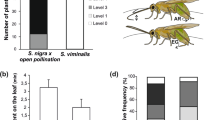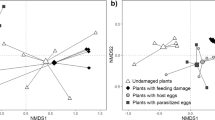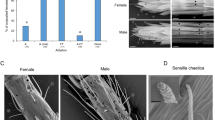Abstract
Although several studies have elucidated the role of plant epicuticular waxes in host recognition and oviposition by herbivorous insects, there is little known about this subject in Chrysomelidae. In the present study, chemical cues for host recognition behavior and oviposition by the monophagous chrysomelid species Cassida stigmatica were investigated with special regard to surface waxes of the host plant, Tanacetum vulgare (Asteraceae). After hibernation in the soil, adults of this species must climb the plant's petioles, which emerge from the ground in spring. The response of adult C. stigmatica to contact and volatile cues from petioles and leaves of T. vulgare was investigated in a “stem arena,” in which differently treated petioles and petiole dummies were offered. Volatile and contact cues of T. vulgare petioles served as well for host recognition. The contact cues were isolated from the petioles and leaves by hexane extraction and by cellulose acetate treatment, which removed cuticular waxes. The attractive volatiles were not extracted sufficiently by hexane. To examine the role of cuticular waxes of the host leaf surface in oviposition, female C. stigmatica were offered intact leaflets and leaflets from which cuticular waxes had been stripped by cellulose acetate treatment. Females did not discriminate between intact and stripped leaflets when only the upper leaf surfaces were offered. However, when the lower leaf surfaces that are generally used as oviposition sites were offered, C. stigmatica preferred to lay eggs on intact leaflets. We conclude that waxes of the lower leaf surface contain crucial information for oviposition in C. stigmatica.
Similar content being viewed by others
REFERENCES
ADATI, T., and MATSUDA K. 1993. Feeding stimulants for various leaf beetles (Coleoptera: Chrysomelidae) in the leaf surface wax of their host plants. Appl. Entomol. Zool. 28:319-324.
ANDERSON, J. F., and METCALF, R. L. 1986. Identification of a volatile attractant for Diabrotica and Acalymna spp. from blossoms of Cucurbita maxima Duchesne. J. Chem. Ecol. 12:687-699.
BAKER, E. A., HUNT, G. M., and STEVENS, P. J. G. 1983. Studies of plant cuticle and spray droplet interactions: A fresh approach. Pestic. Sci. 14:645-658.
BERNAYS, E. A., BLANEY, W. M., CHAPMAN, R. F., and COOK, A. G. 1976. The ability of Locusta migratoria L. to perceive plant surface waxes, pp. 35-40, in T. Jermy (ed.). The Host Plant in Relation to Insect Behavior and Reproduction. Plenum, New York.
BERNAYS, E. A., WOODHEAD, S., and HAINES, L. 1985. Climbing by newly hatched larvae of the spotted stalk borer Chilo partellus to the top of sorghum plants. Entomol. Exp. Appl. 39:73-79.
BOHM, B. A., and CONSTANT, H. 1990. Leaf surface terpenoids of Eriodictyon tricholcalyx. Biochem. Syst. Ecol. 18:491-492.
BROOKS, J. S., WILLIAMS, E. H., and FEENY, P. 1996. Quantification of contact oviposition stimulants for black swallowtail butterfly, Papilio polyxenes, on the leaf surfaces of wild carrot, Daucus carota. J. Chem. Ecol. 22:2341-2357.
EIGENBRODE, S. D., and ESPELIE, K. E. 1995. Effects of plant epicuticular lipids on insect herbivores. Annu. Rev. Entomol. 40:171-194.
EIGENBRODE, S. D., and PILLAI, S. K. 1998. Neonate Plutella xylostella responses to surface wax components of a resistant cabbage (Brassica oleracea). J. Chem. Ecol. 24:1611-1627.
EIGENBRODE, S. D., WHITE, C., RHODE, M., and SIMON, C. J. 1998. Epicuticular wax phenotype of the wel mutation and its effect on pea aphid populations in the greenhouse and in the field. Pisum Genet. 29:13-17.
EIGENBRODE, S. D., TIPTON, J. L., and WHITE, M. 1999. Differential cutting by leaf-cutter bees (Megachilidae: Hymenoptera) on leaves of eastern redbud and on Mexican redbuds with different surface waxes. J. Kans. Entomol. Soc. 72:73-81.
FEENY, P., PAAUWE, K. L., and DEMONG, N. J. 1970. Flea beetles and mustard oils: Host plant specificity of Phyllotreta cruciferae and P. striolata adults (Coleoptera: Chrysomelidae). Ann. Entomol. Soc. Am. 63:832-841.
GERSHENZON, J., and CROTEAU, R. 1991. Terpenoids, pp. 165-219, in G. A. Rosenthal and M. R. Berenbaum (eds.). Herbivores: Their Interactions with Secondary Plant Metabolites. Academic Press, New York.
HOPKINS, R. J., BIRCH, A. N. E., GRIFFITHS, D. W., BAUR, R., and STäDLER, E., MCKINLAY, R. G. 1997. Leaf surface compounds and oviposition preference of turnip root fly Delia floralis: The role of glucosinolate and nonglucosinolate compounds. J. Chem. Ecol. 23:629-643.
JEFFREE, C. E. 1986. The cuticle, epicuticular waxes and trichomes of plants, with reference to their structure, functions and evolution, pp. 23-64, in B. Juniper and S. R. Southwood (eds.). Insects and the Plant Surface. Edward Arnold, London.
KLINGAUF, F. 1971. Die Wirkung des Glykosids Phlorizin auf das Wirtswahlverhalten von Rhopalosiphum insertum (Wald. ) und Aphis pomi De Geer (Homoptera: Aphididae). Z. angew. Entomol. 6:41-55.
KOCH, K. 1992. Die Käfer Mitteleuropas. Ökologie, Goecke & Evers, Krefeld.
KOSIOR, A. 1975. Biology, ecology, and economic importance of cassids (Coleptera, Chrysomelidae, Cassidinae) of the Ojców National Park. Acta Zool. Cracov. 20:251-392.
LIN, S., BINDER, B. F., and HART, E. R. 1998. Insect feeding stimulants from the leaf surface of Populus. J. Chem. Ecol. 24:1781-1790.
MITCHELL, B. K. 1994. The chemosensory basis of host-plant recognition in Chrysomelidae, pp. 141-152, in P. H. Jolivet, M. L. Cox, and E. Petitpierre (eds.): Novel Aspects of the Biology of Chrysomelidae. Kluwer Academic Publishers, Dordrecht.
MORRIS, B., FOSTER, S., and HARRIS, M. 2000. 1-Octacosanal and 6-methoxy-2-benzoxazolinone: Compounds from wheat leaf wax that stimulate oviposition by the Hessian fly, Mayetiola destructor. J. Chem. Ecol. 26:859-873.
MüLLER, C. 1999. Chemische Ökologie des Phytophagenkomplexes an Tanacetum vulgare L. (Asteraceae). PhD dissertation. Free University of Berlin, Germany. Logos-Verlag, Berlin.
MüLLER, C., and HILKER, M. 2000. The effect of a green leaf volatile on host plant finding by larvae of a herbivorous insect. Naturwissenschaften 87:216-219.
NOLDUS, L. P. J. J., POTTING, R. P. J., and BARENDREGT, H. E. 1991. Moth sex pheromone adsorption to leaf surface: Bridge in time for chemical spies. Physiol. Entomol. 16:329-344.
PREMACHANDRA, G. S., HAHN, D. T., and JOLY, R. J. 1993. A simple method for determination of abaxial and adaxial epicuticular wax loads in intact leaves of Sorghum bicolor. L. Can. J. Plant Sci. 73:521-524.
RENWICK, J. A. A., RADKE, C. D., SACHDEV-GUPTA, K., and STäDLER, E. 1992. Leaf surface chemicals stimulating oviposition by Pieris rapae on cabbage. Chemoecology 3:33-38.
SCHOONHOVEN, L. M., JERMY, T., and LOON, J. J. A. V. 1998. Insect-Plant Biology. From Physiology to Evolution. Chapman & Hall, London.
SPENCER, J. L. 1996. Waxes enhance Plutella xylostella oviposition in response to sinigrin and cabbage homogenates. Entomol. Exp. Appl. 81:165-173.
STäDLER, E. 1986. Oviposition and feeding stimuli in leaf surface waxes. pp. 105-121, in B. Juniper and R. Southwood (eds.). Insects and the Plant Surface. Edward Arnold, London.
STäDLER, E., and ROESSINGH, P. 1990. Perception of surface chemicals by feeding oviposition insects. Symp. Biol. Hung. 39:71-86.
STORK, N. E. 1980. Role of waxblooms in preventing attachment to brassicas by the mustard beetle, Phaedon cochleariae. Entomol. Exp. Appl. 28:100-107.
TEUSCHER, E., and LINDEQUIST, U. 1994. Biogene Gifte. Gustav Fischer, Stuttgart.
VARELA, L., and BERNAYS, E. A. 1988. Behavior of newly hatched potato tuber moth larvae, Phthorimaea operculella Zell. (Lepidoptera: Gelichiidae), in relation to their host plants. J. Insect Behav. 1:261-275.
VINCENT, C., and STEWART, R. K. 1984. Effect of allyl isothiocyanate on field behavior of cruciferfeeding flea beetles (Coleoptera: Chrysomelidae). J. Chem. Ecol. 10:33-39.
VISSER, J. H. 1986. Host odor perception in phytophagous insects. Ann. Rev. Entomol. 31:121-144.
WALADDE, S. M., and OCHIENG, S. A. 1990. Tarsi and ovipositor gustatory sensilla of Maruca testulalis: Coding properties and behavioral responses. Symp. Biol. Hung. 39:551-552.
WHITAKER, J. R., and LEE, C. Y. 1995. Recent advances in chemistry of enzymatic browning. pp. 2-7, in C. Y. Lee and J. R. Whitaker (eds. ). Enzymatic Browning and Its Prevention. American Chemical Society, Washington, D.C.
WILLMER, P. 1986. Microclimatic effects on insects at the plant surface, pp. 65-80, in B. Juniper and S. R. Southwood (eds.). Insects and the Plant Surface. Edward Arnold, London.
YANG, G., ESPELIE, K. E., TODD, J. W., CULBREATH, A. K., PITTMAN, R. N., and DEMSKI, J.W. 1993. Cuticular lipids from wild and cultivated peanut species and the relative resistance of these peanut species to fall armyworm and thrips. J. Agric. Food Chem. 41:814-818.
Author information
Authors and Affiliations
Rights and permissions
About this article
Cite this article
Müller, C., Hilker, M. Host Finding and Oviposition Behavior in a Chrysomelid Specialist--the Importance of Host Plant Surface Waxes. J Chem Ecol 27, 985–994 (2001). https://doi.org/10.1023/A:1010343205114
Issue Date:
DOI: https://doi.org/10.1023/A:1010343205114




